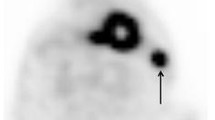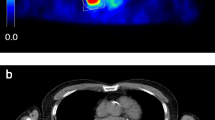Abstract
Purpose
There are several potential advantages of using 18-fluor-fluorodeoxiglucose (18F-FDG) PET for target volume contouring, but before PET-based gross tumor volumes (GTVs) can reliably and reproducibly be incorporated into high-precision radiotherapy planning, operator-independent segmentation tools have to be developed and validated. The purpose of the present work was to apply the adaptive to the signal/background ratio (RS/B) thresholding method for head and neck tumor delineation, and compare these GTVPET to reference GTVCT volumes in order to assess discrepancies.
Materials and methods
A cohort of 19 patients (39 lesions) with a histological diagnosis of head and neck cancer who would undergo definitive concurrent radiochemotherapy or radical radiotherapy with intensity-modulated radiotherapy technique (IMRT), were enrolled in this prospective study. Contouring on PET images was accomplished through standardized uptake value (SUV)-threshold definition. The threshold value was adapted to RS/B. To determine the relationship between the threshold and the RS/B, we performed a phantom study. A discrepancy index (DI) between both imaging modalities, overlap fraction (OF) and mismatch fraction (MF) were calculated for each lesion and imaging modality.
Results
The median DI value for lymph nodes was 2.67 and 1.76 for primary lesions. The OF values were larger for CT volumes than for PET volumes (p < 0.001), for both types of lesions. The MF values were smaller for CT volumes than for PET volumes (p < 0.001), for both types of lesions. The GTVPET coverage (OFPET) was strongly correlated with the lesion volume (GTVCT) for metastatic lymph nodes (Pearson correlation = 0.665; p < 0.01). For smaller lesions, despite the GTV volumes were relatively larger on PET than in CT contours, the coverage was poorer. Accordingly, the MFPET/CT was negatively correlated with the lesion volume for metastatic lymph nodes.
Conclusions
The present study highlights the considerable challenges involved in using FDG PET imaging for the delineation of GTV in head and neck neoplasms. The methods that rely mainly on SUVmax for thresholding, as the RS/B method, are very sensitive to partial volume effects and may provide unreliable results when applied on small lesions.

Similar content being viewed by others
References
Troost EGC, Schinagl DAX, Bussink J et al (2010) Innovations in radiotherapy planning of head and neck cancers: role of PET. J Nucl Med 51:66–76
Riegel AC, Berson AM, Destian S et al (2006) Variability of gross tumor volume delineation in head-and-neck cancer using CT and PET/CT fusion. Int J Radiat Oncol Biol Phys 65:726–732
Greco C, Nehmeh SA, Schöder H et al (2008) Evaluation of different methods of 18F-FDG-PET target volume delineation in the radiotherapy of head and neck cancer. Am J Clin Oncol 31:439–445
Schinagl DA, Vogel WV, Hoffmann AL et al (2007) Comparison of five segmentation tools for 18F-fluoro-deoxy-glucose-positron emission tomography-based target volume definition in head and neck cancer. Int J Radiat Oncol Biol Phys 69:1282–1289
Daisne JF, Sibomana M, Bol A et al (2003) Tridimensional automatic segmentation of PET volumes based on measured source-to-background ratios: influence of reconstruction algorithms. Radiother Oncol 69:247–250
Daisne JF, Duprez T, Weynand B et al (2004) Tumor volume in pharyngolaryngeal squamous cell carcinoma: comparison at CT, MR imaging, and FDG PET and validation with surgical specimen. Radiology 233:93–100
Torres J, Carrascosa CB, Arjona J et al (2008) Determinación del umbral de captación para la segmentación automática de volúmenes en radioterapia: Estudio en maniquí. XXIX Congreso de la SEMN, Valencia
Adams MC, Turkington TG, Wilson JM, Wong TZ (2010) A systematic review of the factors affecting accuracy of SUV measurements. AJR 195:310320
Henriques de Figueiredo B, Barret O, Demeaux H et al (2009) Comparison between CT- and FDG-PET-defined target volumes for radiotherapy planning in head-and-neck cancers. Radiother Oncol 93:479–482
Murphy JD, Chisholm KM, Daly ME et al (2011) Correlation between metabolic tumor volume and pathologic tumor volume in squamous cell carcinoma of the oral cavity. Radiother Oncol 101:356–361
Guido A, Fuccio L, Rombi B et al (2009) Combined 18F-FDG-PET/CT imaging in radiotherapy target delineation for head-and-neck cancer. Int J Radiat Oncol Biol Phys 73:759–763
Delouya G, Igidbashian L, Houle A et al (2011) 18F-FDG-PET imaging in radiotherapy tumor volume delineation in treatment of head and neck cancer. Radiother Oncol 101:362–368
Rothschild S, Studer G, Seifert B et al (2007) PET/CT staging followed by intensity-modulated radiotherapy (IMRT) improves treatment outcome of locally advanced pharyngeal carcinoma: a matched-pair comparison. Radiat Oncol 2:22–31
Vernon MR, Maheshwari M, Schultz CJ et al (2008) Clinical outcomes of patients receiving integrated PET/CT-guided radiotherapy for head and neck carcinoma. Int J Radiat Oncol Biol Phys 70:678–684
Soto D, Kessler ML, Piert M, Eisbruch A (2008) Correlation between pretreatment FDG-PET biological target volume and anatomical location of failure after radiation therapy for head & neck cancers. Radiother Oncol 89:13–18
El-Bassiouni M, Ciernik IF, Davis JB et al (2007) [18FDG] PET-CT-based intensity-modulated radiotherapy treatment planning of head and neck cancer. Int J Radiat Oncol Biol Phys 69:286–293
Burri RJ, Rangaswamy B, Kostakoglu L et al (2008) Correlation of positron emission tomography standard uptake value and pathologic specimen size in cancer of the head and neck. Int J Radiat Oncol Biol Phys 71:682–688
Deantonio L, Beldi D, Gambaro G et al (2008) FDG-PET/CT imaging for staging and radiotherapy treatment planning of head and neck carcinoma. Radiat Oncol 3:29–35
Newbold KL, Partridge M, Cook G et al (2008) Evaluation of the role of 18FDG-PET/CT in radiotherapy target definition in patients with head and neck cancer. Acta Oncol 47:1229–1236
Yu H, Caldwell C, Mah K et al (2009) Automated radiation targeting in head-and-neck cancer using region-based texture analysis of PET and CT images. Int J Radiat Oncol Biol Phys 75:618–625
Kao CH, Hsieh TC, Yu CY et al (2010) 18F-FDG PET/CT-based gross tumor volume definition for radiotherapy in head and neck cancer: a correlation study between suitable uptake value threshold and tumor parameters. Radiat Oncol 5:76–84
Moule RN, Kayani I, Moinuddin SA et al (2010) The potential advantages of (18)FDG PET/CT-based target volume delineation in radiotherapy planning of head and neck cancer. Radiother Oncol 97:189–193
Conflict of interest
None.
Author information
Authors and Affiliations
Corresponding author
Rights and permissions
About this article
Cite this article
Perez-Romasanta, L.A., Bellon-Guardia, M., Torres-Donaire, J. et al. Tumor volume delineation in head and neck cancer with 18-fluor-fluorodeoxiglucose positron emission tomography: adaptive thresholding method applied to primary tumors and metastatic lymph nodes. Clin Transl Oncol 15, 283–293 (2013). https://doi.org/10.1007/s12094-012-0914-z
Received:
Accepted:
Published:
Issue Date:
DOI: https://doi.org/10.1007/s12094-012-0914-z




